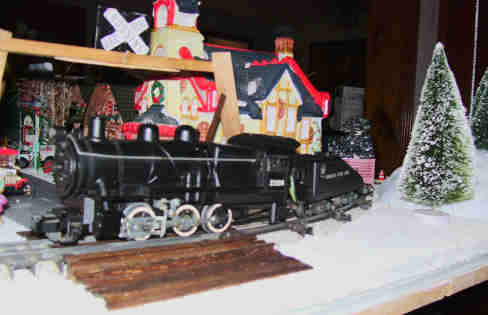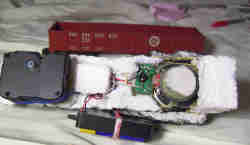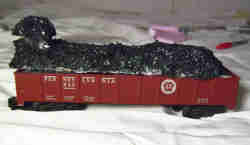American Flyer Sports
Innovative DIY Sound System
Many of us can remember when Lionel and American Flyer were dueling it out for the loop around the Christmas tree base, but today, finding such a train intact is rare, finding one that can actually run the circle will prove to be an expensive find.
Imagine a modeler painting an apartment and in a closet coming across a complete boxed American Flyer train including the rare and uncataloged 0-6-0 locomotive with the slope-back tender, the rocket freight car, a rare car carrier complete with a blue semi and all five cars. The set also included the gondola and a caboose. There wasn’t any track, but there was a 100-watt transformer.
The engine alone would bring over $500 on eBay and the other five cars would bring in another $100 or $200. But that is not destiny for these pieces.
“I couldn't believe someone could forget such a beautiful train set, I had one similar when I was a child (my dad sold it!),” said John Thompson, Butler, MO who sent this article to
www.scale-modelers-handbook.com .

Thompson put the American Flyer set away in a closet where it remained for about a decade thinking he would have a hard time finding the track. But he found an ample supply of S Scale supplies on eBay and started planning a layout which would measure 4X12.
After cleaning and lubricating, Thompson ran a few test runs and found the engine and cars performed flawlessly. “She runs perfect, she even smokes and chug chugs loudly,” he added.
Speaking of adding, that is what he wanted to do next – add steam whistle sounds. But the original ones are all stationary (not a good effect for a layout) not to mention pricey considering I am on a budget.
DIY Sound System For Less Than A BuckThompson had an epiphany, several months earlier while shopping garage sales. He purchased a battery operated large round train clock with sounds for 25 cents. It makes steam, bell, whistle, and chug sounds. This clock had 2 separate batteries 1 for clock and 1 for sound , which was perfect for his needs.
 “I took the clock apart, removed clock mechanism (it was the switch for sound), hourly sounds as you turn the clock setting knob, and since you don't have power to the clock you can turn it to activate,” Thompson explained. He added There are two different positions as you turn the clock mechanism. When you hear it click it turns on sound , goes through all sounds and stops or keep turning it to just where you think it will click and it will remain on until you finish turning it to where it clicks again.
“I took the clock apart, removed clock mechanism (it was the switch for sound), hourly sounds as you turn the clock setting knob, and since you don't have power to the clock you can turn it to activate,” Thompson explained. He added There are two different positions as you turn the clock mechanism. When you hear it click it turns on sound , goes through all sounds and stops or keep turning it to just where you think it will click and it will remain on until you finish turning it to where it clicks again.
I also removed the computer board and speaker (be careful with the wires they are very delicate). The remaining parts were to large for my slant back tender, so i thought why not put it in the gondola ,everything fit perfect with the exception of the speaker. I found it would rest on the edge of gondola. He took a piece of 5/8 " white foam and cut it just a little larger than the size of the gondola ,traced the shape of the clock mechanism and speaker on to it and carefully cut them out to half the depth of foam. Some of the foam had to be a little thin on the sides to fit correctly. He cautioned others, “be careful with your box knife or whatever you use to cut”, he added.

Thompson instructed others who try this to be sure to trace and ream out the holes for the clock mechanism in the front and the speaker in the back of the foam. This is needed so you can lay the computer board in the middle of the bottom of the gondola.
Now glue a small wooden dowel ( about 1.5" long) to the clock adjustment knob, (epoxy worked well for this). “It adhered well to the little ridges on the knob, but be careful don't put to much on or you will glue your knob where it won't turn.” He cautioned and added “now you can make a hole to put the wooden dowel through where you cut out the clock mechanism hole using something like a small drillbit to make several holes in the foam where the speaker goes, for a loud and clear sound.
The speaker will be showing a little on each side. Thompson suggested cutting two small rectangles of foam to glue over sides of speaker. He Used Liquid Nails (in the tube) as it is friendly to foam. This glues every thing and he uses a few toothpicks pushed into foam to help hold everything in except the circuit board which you will lay it in the gondola, put a thin piece of foam in gondola for cushion just under circuit board. You will also have to use a rotary tool to cut off the battery compartment (for the clock) so you will be able to fit it in the gondola.
Now you can cut two small pieces (essentially rectangles) of foam the width of gondola and your foam insert, glue on the underside over the rear of insert. The other one goes in front (to hold it in gondola). Also cut a small cube of foam and glue on to dowel.
After all glue dries, carefully carve or make slight small pinches on foam surface to resemble coal. He also suggested painting the foam very lightly with black spray paint. not to much or it will melt your coal load to nothing. Now paint all with black acryllic paint to look just like coal, insert all into gondola, the ribs in gondola will cause you to make adjustments but you will get it in there.
Carefully turn the dowel with the foam you glued on it and voila you have train sounds at a budget price. I hope this tip helps people like me on a budget. This whole project took about 1 day to complete, It was worth the effort. Don't forget to put in the battery!! Look for those train clocks at sales. I'm looking for another for my life like train!
Enjoy, a fellow railroader, If you have questions, contact
John Thompson


